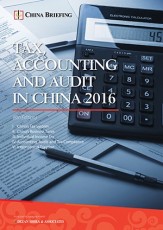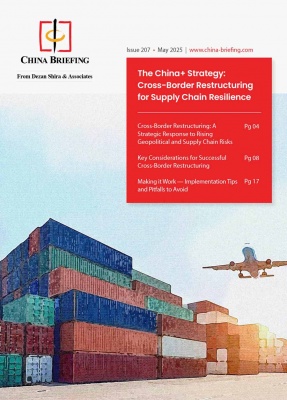Case Study: Capital Gain Tax Treatment- Part 2: Capital Gain Tax Calculation
By Ines Liu
Hong Kong entered into a Double Taxation Arrangement (DTA) with China in 2006. The treaty acts as a way to avoid double taxation and clamp down on tax evasion, improving ties between both jurisdictions by reinforcing their respective tax laws, encouraging competition, and promoting investment. A fourth protocol was signed on April 1, 2015, amending four key aspects of the DTA. One of those aspects was a tax exemption for capital gains derived by foreign investors that sell shares of a China-based company, which was looked at in part one of this case study. Part two of the case study will approach issues that Company A should be aware of when applying for a capital gains tax exemption, and how to calculate the capital gain tax of restricted shares.
Capital Gain tax calculation through Selling Restricted Shares: Scenario
A global high profile venture capital holding company had a subsidiary incorporated in Hong Kong (Company A). Company B was a private Chinese company and decided to become a listed company. Before Company B became listed, Company A purchased restricted shares* of Company B. Company A planned to sell their shareholdings after a 12-month restricted stock trade period. Subsequently, Company A transferred RMB 20 million from Company B, which accounted for 32 percent of Company B’s total shares. Company B then launched a share reform scheme to increase registered capital to meet the China Securities Regulatory Commission’s requirements. The registered capital of Company B was RMB 70 million, and needed to increase to RMB 100 million. The remaining RMB 30 million was comprised of the following:
- Contributed surplus: 13 million
- Legal earned surplus reserve: 7 million
- Undistributed profit: 10 million
Due to the change of registered capital, the percentage of company A’s share decreased to 30 percent. Thus, the question stands – how are the differing components of the remaining RMB 30 million registered capital taxed?
*Restricted stock is not freely tradable, and for many investors, restricted stock holdings may constitute a large portion of their net assets.
![]() RELATED: Tax and Compliance Services from Dezan Shira & Associates
RELATED: Tax and Compliance Services from Dezan Shira & Associates
Definitions and axioms
First let’s look at definition of technical terminology:
- Registered capital: Capital approved by government authorities and invested by shareholders.
- Contributed surplus: Amount of money that a company earns from sources other than its profits.
For example, when a company issues and sells shares at a price greater than their face value. The contributed surplus figure helps both investors and the company to distinguish between non-operational and operational income.
- Earned surplus reserve: Earnings not paid out as dividends but instead reinvested in the core business or used to pay off debt.
- Undistributed profit: Profit that has not been distributed as dividends to stockholders.
- Capital Gain = Selling Price – Cost of Investment.
- Value-added portion: Total proceeds after subtracting the deductible cost of investment.
- Capital contribution: The registered capital increase converted from net assets.
Analysis
Regulations issued by the State Administration of Taxation (SAT), namely Guo Shui Han (2009) notice No. 698, Article 3, clarifies the treatment of capital gains:
“Gains derived from transfer of equity shall refer to the balance amount after deducting the cost price of the equity from the transfer price of the equity. Cost price of equity shall mean the capital contribution amount actually paid to the Chinese resident enterprise at the time of investment and equity participation by the transferor of the equity, or the equity transfer amount actually paid to the original transferor of the said equity at the time of purchase of such equity.”
Thus, the cost of investment refers to the consideration originally paid by Company A to acquire Company B’s shares. Therefore, the RMB 20 million which was transferred from Company B will be treated as the cost of investment in capital gains tax computation.
Given the PRC Corporate Income Tax (CIT) Law and its implementation rule, as well as Notice No. 698, the equity shares which were converted from capital surplus cannot be regarded as the cost of investment in capital gains tax computation. However, when the registered capital was converted from legal earned surplus reserve and undistributed profit, it was split into two taxable events: 1) the profit declared as a dividend; and 2) the dividends re-injected into Company B. Therefore, the conversion of surplus reserve and undistributed profit can be regarded as the capital contribution, and thus can constitute the deductible cost of investment in capital gain tax computation.
![]() RELATED: Business Advisory Services from Dezan Shira & Associates
RELATED: Business Advisory Services from Dezan Shira & Associates
Furthermore, during Company B’s Share Reform, Company B also converted undistributed profit into the capital reserves. Chinese tax authorities imposed a 10 percent withholding dividend tax during the conversion. Therefore, this capital reserve can be regarded as the capital contribution and a portion of the cost of investment.
A new circular for disposal shares
According to Circular 53, which became effective on September 1, 2016, the section regarding accounting of disposals/selling of trading securities states that any transactions taking place before September 1, 2016 should be subject to a six percent VAT rate on the actual value-added portion. Furthermore, Clause 10 states that “Taxable events which occurred prior to this date but have not been dealt with shall be handled pursuant to this provision of this circular.” In light of this, Dezan Shira & Associates has attempted to negotiate with tax authorities that the legislation does not apply for Company A’s transaction, however, they claim that the legislation has a retrospective effect, hence Company A should pay withholding VAT for stock selling.
Circular 36 is the fundamental regulation on taxation expansion of the VAT reform. It clarifies the scope of taxpayers, scope of taxable activities, etc. The following is a summary of the points relevant to this case from the circular:
- Article 1: States that VAT taxpayers include all entities and individuals.
- Article 6: Clarifies that overseas entities who conduct taxable activities within China must pay VAT through its withholding agent.
- Article 12: Clarifies that taxable activities within China refer to any purchaser of services that is located in China.
- Article 13: States that activities which are not subject to VAT must be performed outside of China.
Therefore, from the above analysis, it can be deduced that capital gain tax over selling restricted shares should be subject to withholding tax and VAT on taxable activities in China.
Conclusion
In this second part of the case study, the question of how to calculate the capital gain tax was raised. It is crucial to define the cost of investment in order to calculate capital gain. However, the capital conversion during the share reform seen in this case study is a particularly unique situation, and current tax regulation does not expand on capital contribution. Therefore, it is advisable to consult relevant tax authorities to obtain proper guidance in respect of this. Furthermore, as Circular 53 states, any transactions made before September 1, 2016 are to be subject to a six percent VAT rate on the actual value-added portion. This recent development affects the situation explored in part one of this case study, which discussed the tax exposure and implication of capital gain, which is also subject to VAT on taxable activities in China.
|
Asia Briefing Ltd. is a subsidiary of Dezan Shira & Associates. Dezan Shira is a specialist foreign direct investment practice, providing corporate establishment, business advisory, tax advisory and compliance, accounting, payroll, due diligence and financial review services to multinationals investing in China, Hong Kong, India, Vietnam, Singapore and the rest of ASEAN. For further information, please email china@dezshira.com or visit www.dezshira.com. Stay up to date with the latest business and investment trends in Asia by subscribing to our complimentary update service featuring news, commentary and regulatory insight.
|

 Tax, Accounting, and Audit in China 2016
Tax, Accounting, and Audit in China 2016
This edition of Tax, Accounting, and Audit in China, updated for 2016, offers a comprehensive overview of the major taxes that foreign investors are likely to encounter when establishing or operating a business in China, as well as other tax-relevant obligations. This concise, detailed, yet pragmatic guide is ideal for CFOs, compliance officers and heads of accounting who must navigate the complex tax and accounting landscape in China in order to effectively manage and strategically plan their China-based operations.
 An Introduction to Doing Business in China 2016
An Introduction to Doing Business in China 2016
Doing Business in China 2016 is designed to introduce the fundamentals of investing in China. Compiled by the professionals at Dezan Shira & Associates in June 2016, this comprehensive guide is ideal not only for businesses looking to enter the Chinese market, but also for companies who already have a presence here and want to keep up-to-date with the most recent and relevant policy changes
 An Introduction to Doing Business in Hong Kong 2016
An Introduction to Doing Business in Hong Kong 2016
Doing Business in Hong Kong 2016 is designed to introduce the fundamentals of investing in Hong Kong. Compiled by the professionals at Dezan Shira & Associates, this comprehensive guide is ideal not only for businesses looking to enter the Hong Kong market, but also for companies that already have a presence here and want to keep up-to-date with the most recent and relevant policy changes.
- Previous Article Presentation: Accounting and Tax Compliance in China
- Next Article China’s New Related Party Transaction Reporting Regulation: Implications for Annual Audit in China



























